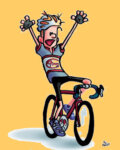Tips for Riding in Snow/Adverse Conditions
Our Community › Forums › General Discussion › Tips for Riding in Snow/Adverse Conditions
- This topic has 65 replies, 35 voices, and was last updated 9 years, 6 months ago by
 Boomer Cycles.
Boomer Cycles.
-
CreatorTopic
-
October 10, 2014 at 1:05 pm #915967
Tim Kelley
ParticipantI’m putting together a piece for winter riding, with a focus on how to ride when it’s snowing or when there is snow or ice on the ground.
I’d welcome any suggestions you have for your favorite tips. Like:
-If you are riding through slick areas, try to apply pressure to the pedals evenly. Don’t mash the pedals up and down or else the rear wheel can spin out.
-If you see a short slick patch ahead, enter it with your front wheel pointing straight and don’t turn while you’re in the slick patch to keep from losing your balance
-Wider tires, or tires with studs in the can provide more traction on slick or loose surfaces
-If it’s really icy, sometimes the best course of action is to get off and walk your bike.
Anyone got anything to suggest?
-
CreatorTopic
-
AuthorReplies
-
February 27, 2015 at 8:28 pm #1024297
 Steve OParticipant
Steve OParticipant@APKhaos 109685 wrote:
Don’t underestimate the dangers of sub 30s temps if you are forced stop riding and have no shelter avaliable.
That’s why I always stop at Java Shack or Best Buns or Swings or Amore or. . . .
 February 27, 2015 at 11:22 pm #1024305
February 27, 2015 at 11:22 pm #1024305Alcova cyclist
ParticipantI’ve been riding flat pedals all winter, which I find is much easier for flintstoning. I’ve also taken to wearing hiking boots when it’s really cold or icy/snowy. I’ve been very glad to have them when forced to walk the bike through icy ruts and snowbanks.
February 28, 2015 at 2:05 am #1024308brendan
Participant@APKhaos 109685 wrote:
Not one but TWO pinch flats. Within 10-15 minutes of stopping I began to get seriously cold. The gear that had kept me perfectly comfortable while riding was not doing the job once off the bike. I had a miserable walk to Falls Church rather than spend 30 mins or so fixing the two flats. Don’t underestimate the dangers of sub 30s temps if you are forced to stop riding and have no shelter avaliable.
This is actually my greatest fear about winter commuting, esp. now that I have a new wheelset. The rhyno lites result in a MUCH tighter fit with tires than the original salsa gordos I had on the bike. It take me about 3-4 times as long to swap tubes…at home! My previous experiences with winter flats were somewhat harrowing before the rim change, now I’m fairly certain that I should prioritize finding shelter instead of taking the wheel off if the temperature is near or below freezing. And there are parts of my commute where that’s difficult.
Also, as a general rule, I’ve learned it’s important to layer up once I stop having to shed ride/muscle heat. In the winter, as soon as I get off the bike to perform a repair, the first thing I do is put another layer on.
B
February 28, 2015 at 2:28 pm #1024315hozn
ParticipantYou might want to invest in a Crank Bros Speed Lever; makes tire change on tight rims much easier (or doable at all, on really tight setups).
February 28, 2015 at 5:20 pm #1024322brendan
Participant@hozn 109710 wrote:
You might want to invest in a Crank Bros Speed Lever; makes tire change on tight rims much easier (or doable at all, on really tight setups).
Thanks, I’ll check the Speed and Speedier levers out!
B
March 6, 2015 at 9:02 pm #1024957 Steve OParticipant
Steve OParticipantSeveral people reported going down today and many have expressed trepidation about riding on snow and ice.
This morning I rode to Java Shack, back home (near EFC) and back to Rosslyn on my 3-speed Western Flyer with wide slicks (see photo below), and–with just one momentary exception–felt pretty comfortable the whole time. Most of this was on the Custis, but some was on streets, too.I’m not saying this to boast, but to relay the fact that it is possible, and pretty safe, to ride in these conditions if you use the proper techniques.
I think the #1 tip is to avoid using your front brake. If you skid your rear tire, you will slide sideways, but you probably won’t go down. (That was my one time this morning: on a downhill a truck presented itself as an obstacle while I was literally on a 20-foot patch of ice. I locked up the back wheel, but did not apply the front brake, but rather steered across the ice toward the packed snow along the side of the road. My bike slid partially sideways, but did not fall over, and when I hit the snow, everything straightened back out. If I had hit the front brake [which is one’s tendency], I would surely have gone down. I wasn’t travelling too fast to start with, so even if I had gone down, I probably would have only bruised my pride.)
#2 – Keep moving–straight and steady. A moving bike is much more stable than a walking or running person, and way, way more stable than a still bike. You don’t have to go very fast, but as long as you are moving in a straight line your bike will virtually always stay up–even on pretty slick surfaces. Try to keep your pedaling as smooth and steady as possible, so that your rear wheel applies a constant pressure.
#3 – Plan ahead.
– If you are going to be crossing an ice field, plan ahead for your exit spot, and plot a straight line to it.
– If you are going to be heading down a hill, slow way down before the beginning, so that you can roll slowly down without needing your front brake
– Turns can be dangerous, just like using the front brake, so slow down and plan your turns before you start them.#4 – When navigating actual snow (like an inch or more deep), you may find that standing up and pedaling is more comfortable. I’m not sure what it is about controlling the bike, but having the bike slide around while you are standing and pedaling is much less troubling than while sitting–at least for me. A more advanced skill is to stand and shift your weight backwards, so that your rear wheel has more weight, and hence more traction, to keep you going. This is helpful on uphills when you don’t want to come to a dead stop. Riding in actual snow is harder work, but far less likely to result in falls than on icy surfaces.
As you can see, my avatar above is riding straight and steady on an ice patch–no hands, even!–and is not falling over. So it can be done.
The street I am standing on in the photo below–taken this morning–is completely rideable, even on a road bike (not recommended, though; my druthers is my heavier, wider-tired, 3-speed), if you use the techniques above.
@Boomer2U 110311 wrote: March 6, 2015 at 9:29 pm #1024965
March 6, 2015 at 9:29 pm #1024965PotomacCyclist
ParticipantHopefully today is the last weekday of the season where we have to put up with snowy/icy roads and trails. A lot of the mess is going to melt very soon. If not Sat., definitely by Sun., with little chance of overnight refreezing after Sat. afternoon.
March 6, 2015 at 10:02 pm #1024974brendan
ParticipantThe trick about keeping the rear wheel loaded is important. I had more trouble today riding the cargo bike, particularly on slushy/icy uphills, because I had little to no cargo, depending on the segment of my ride. Since the rear wheel is much farther away from me than on a standard bike, it was harder to keep it properly weighted to prevent spinning.
B
March 6, 2015 at 10:43 pm #1024978 KWLParticipant
KWLParticipant@Steve O 110378 wrote:
As you can see, my avatar above is riding straight and steady on an ice patch–no hands, even!–and is not falling over. So it can be done.
Sure, in Frazz’s cartoon world.
 March 6, 2015 at 10:43 pm #1024979
March 6, 2015 at 10:43 pm #1024979PotomacCyclist
Participant@hozn 109710 wrote:
You might want to invest in a Crank Bros Speed Lever; makes tire change on tight rims much easier (or doable at all, on really tight setups).
I never heard of these before. I just looked up a couple YouTube videos. They seem to work much better than the smaller levers, but is this the case with every type of tire/rim set-up? Someone mentioned snapping one of them. Are they sturdy? Do they work as advertised?
March 6, 2015 at 11:15 pm #1024984hozn
ParticipantThey work very well for me, though I don’t get flats often (now I will get one) so have only used them for one tire change. But changing Conti tires on my Flo30 rims would be virtually impossible with regular levers. (At home, I use a tire jack to install the tires on these.)
My only complaint with these levers is that they are large/long, so they stretch the limits (literally) of my diminutive lezyne saddlebag.
March 7, 2015 at 12:08 am #1023896scoot
Participant@brendan 110396 wrote:
I had more trouble today riding the cargo bike, particularly on slushy/icy uphills, because I had little to no cargo
Ice chunks = hitchhikers?
January 17, 2016 at 8:09 pm #1045468 Steve OParticipant
Steve OParticipantAlthough today’s snow was not enough to create any worries about riding conditions, I got some complaints last year that I posted this advice at the end of FS instead of the beginning. so with snow in the forecast for late this week, I hereby present this reprise:
@Steve O 110378 wrote:Several people reported going down today and many have expressed trepidation about riding on snow and ice.
This morning I rode to Java Shack, back home (near EFC) and back to Rosslyn on my 3-speed Western Flyer with wide slicks (see photo below), and–with just one momentary exception–felt pretty comfortable the whole time. Most of this was on the Custis, but some was on streets, too.I’m not saying this to boast, but to relay the fact that it is possible, and pretty safe, to ride in these conditions if you use the proper techniques.
I think the #1 tip is to avoid using your front brake. If you skid your rear tire, you will slide sideways, but you probably won’t go down. (That was my one time this morning: on a downhill a truck presented itself as an obstacle while I was literally on a 20-foot patch of ice. I locked up the back wheel, but did not apply the front brake, but rather steered across the ice toward the packed snow along the side of the road. My bike slid partially sideways, but did not fall over, and when I hit the snow, everything straightened back out. If I had hit the front brake [which is one’s tendency], I would surely have gone down. I wasn’t traveling too fast to start with, so even if I had gone down, I probably would have only bruised my pride.)
#2 – Keep moving–straight and steady. A moving bike is much more stable than a walking or running person, and way, way more stable than a still bike. You don’t have to go very fast, but as long as you are moving in a straight line your bike will virtually always stay up–even on pretty slick surfaces. Try to keep your pedaling as smooth and steady as possible, so that your rear wheel applies a constant pressure.
#3 – Plan ahead.
– If you are going to be crossing an ice field, plan ahead for your exit spot, and plot a straight line to it.
– If you are going to be heading down a hill, slow way down before the beginning, so that you can roll slowly down without needing your front brake
– Turns can be dangerous, just like using the front brake, so slow down and plan your turns before you start them.#4 – When navigating actual snow (like an inch or more deep), you may find that standing up and pedaling is more comfortable. I’m not sure what it is about controlling the bike, but having the bike slide around while you are standing and pedaling is much less troubling than while sitting–at least for me. A more advanced skill is to stand and shift your weight backwards, so that your rear wheel has more weight, and hence more traction, to keep you going. This is helpful on uphills when you don’t want to come to a dead stop. Riding in actual snow is harder work, but far less likely to result in falls than on icy surfaces.
As you can see, my avatar above is riding straight and steady on an ice patch–no hands, even!–and is not falling over. So it can be done.
The street I am standing on in the photo below–taken this morning–is completely rideable, even on a road bike (not recommended, though; my druthers is my heavier, wider-tired, 3-speed), if you use the techniques above.
@Boomer2U 110311 wrote:
 January 17, 2016 at 9:25 pm #1045473
January 17, 2016 at 9:25 pm #1045473 cvcalhounParticipant
cvcalhounParticipant@dasgeh 96785 wrote:
Major roads get cleared first, then secondary roads, then neighborhood roads, then trails. On road, insist on taking the lane — if you slip, you don’t want to slip beside a car. Where appropriate, it’s nice to pull over and let a line of cars built up behind you pass — keeps heads cool, and people sane, especially if you smile and wave as they pass.
At least in Montgomery County, they will also post a map showing which streets have been plowed and which are in the process of being plowed:
http://www7.montgomerycountymd.gov/snowmap/
Thus, it is possible to see when it’s a good idea to delay a ride, or when you can get out if you just walk your bike to the nearest plowed road. I suspect there are similar services in other jurisdictions.
January 18, 2016 at 8:29 pm #1045512 NadineParticipant
NadineParticipantThis picture was taken a year or more ago, right? You don’t have snow on the ground in MD yet… Do you?
-
AuthorReplies
- You must be logged in to reply to this topic.